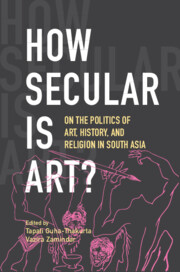8 - Shivaji’s Portrait and the Practice of Art History
Published online by Cambridge University Press: 21 February 2023
Summary
A portrait of Shivaji Bhonsle, crowned Chhatrapati Maharaj of the Maratha territories in western India in 1674, is currently being modelled by the sculptor Ram Sutar for a statue over 200 metres (circa 695 feet) high, projected to rise off the shore of Mumbai. Though the work has stalled due to legal suits—including a plea on the part of local fishermen to retain the use of the waters for their livelihood—the massive bronze cast of Shivaji rearing a horse is emblematic of the symbolic power of this seventeenth-century king today. Yet the likeness that Sutar sculpts has a history; it is rooted in a chromolithograph made by the artist Raja Ravi Varma in the late nineteenth century to centre a growing nationalist movement in western India.
This essay traces Shivaji’s portrait from a range of images made in the seventeenth and eighteenth centuries to those that Ravi Varma and other artists developed in the late nineteenth century. In this period, western Indian nationalists sought a hero-icon for their movement, and the absence of a definitive portrait of Shivaji from his own court became the subject of a fraught debate. The multiple portraits collected at this time reveal their negotiation with a range of deeply rooted traditions of representation in western India—including those of men and of gods—and with those of colonial portraiture and the classification of people.
This aesthetic flexibility was a decisive factor in the transformation of Shivaji’s portrait into a medium of anticolonial resistance. Yet, the multivalence of the image not only stood as a beacon for independence but also as a potent icon for a Hindu polity, which continues to this day. This is a charged image and I treat it with respect as I do Shivaji Maharaj, though the essay is not engaged with him as a historical figure. My purpose here is rather to trace a genealogy of Shivaji’s portrait to historicize and complicate a picture that has become infused with communal politics, and to question the framework of the secular for an image that refuses to be defined as either hero or icon.
- Type
- Chapter
- Information
- How Secular Is Art?On the Politics of Art, History and Religion in South Asia, pp. 227 - 260Publisher: Cambridge University PressPrint publication year: 2024



